Chaos in the dust brings the Giro to life
Plus, a new episode of KM0 is online: Where next for Italian cycling?
New episode for Friends of the Podcast subscribers
Quo Vadis, Italia? Where Next For Italian Cycling?
For 24 hours, Diego Ulissi held the maglia rosa – the first Italian since Alessandro De Marchi in 2021 to hold the lead in the Giro d’Italia. The decline in men’s Italian cycling has been a long, steady one. In the 1996 Tour de France, 62 of the starters – almost a third of the field – were from Italy. Last year, when the grand départ was in Florence, there were only eight. Vincenzo Nibali won all three grand tours during his glittering career but there has been no successor to him.
For their rest day assignment, Daniel Friebe and Brian Nygaard took a deep look at Italian cycling culture to ask how the country can turn its fortunes around. We hear from Movistar sports director Max Sciandri, La Gazzetta dello Sport’s cycling correspondent Ciro Scognamiglio, Lidl-Trek’s manager Luca Guercilena and UAE Team Emirates’ Matxin Fernandez to ask where next for Italian cycling?
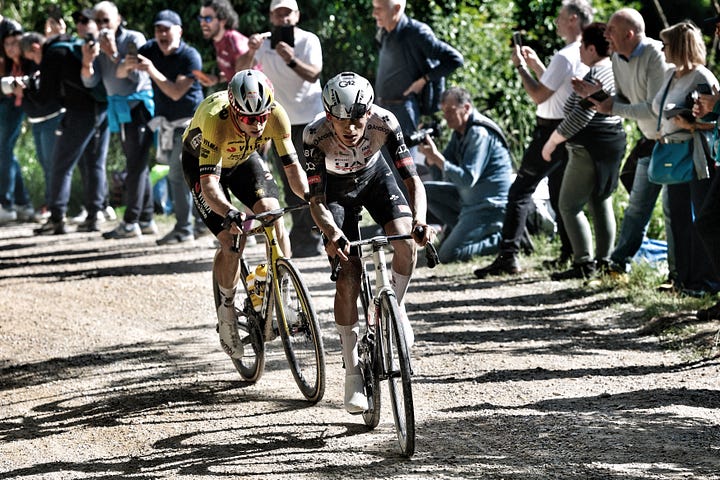
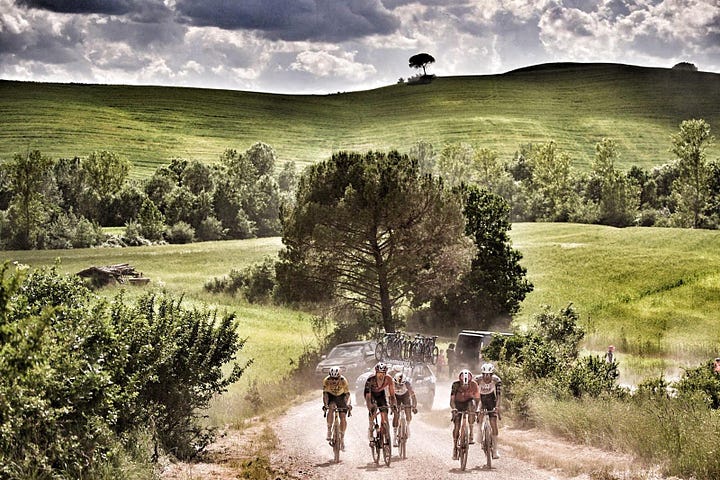
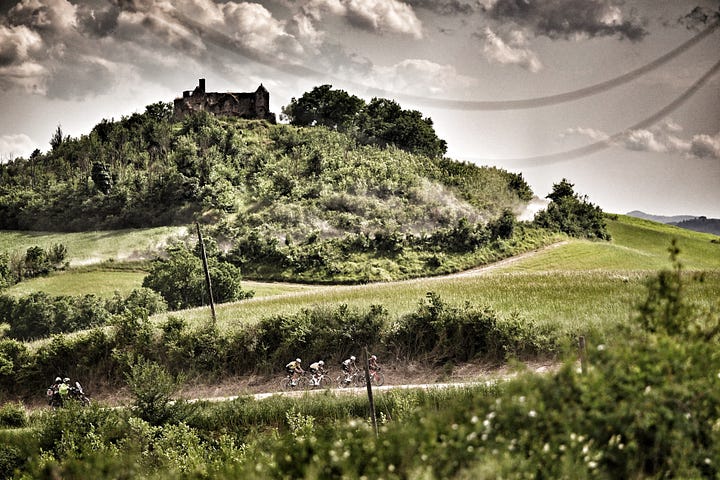
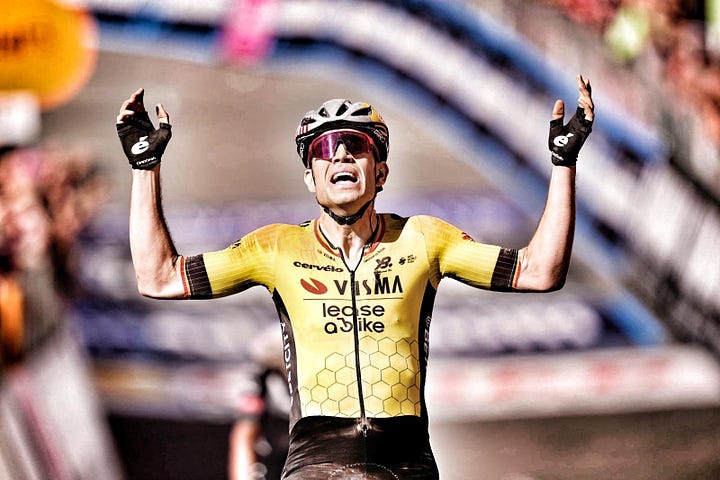
by Lionel Birnie
There was more drama, incident and excitement during Sunday’s gravel stage of the Giro d’Italia than in the previous eight put together.
Fortunately, Adam Yates’s tongue-in-cheek comment to Daniel last week that nothing was going to happen until stage 16 turned out not to be the case. In fact, everything seemed to happen at once in the space of a thrilling couple of hours on the white roads of Tuscany.
Primož Roglič crashed, then punctured and lost significant ground to Juan Ayuso. The Slovenian, who we suspect had hoped for a quietly efficient Giro campaign, now has time to make up, starting with Tuesday’s Tuscan wine trial.
Wout van Aert finally won a race after a spring of near-misses and unfavourable comparisons with the ‘big three’. Perhaps it shouldn’t have been a surprise. He’s always been prominent at Strade Bianche, which covers some of the same dusty gravel roads and finishes in the square in Siena. In four appearances he’s never been worse than fourth. It was the scene of his big breakthrough in 2018 when he was still riding for the small Belgian Vérandas Willems-Crelan team and finished on the podium. He returned in 2020, that scorching lockdown summer, to win the first major race when the season resumed following a break enforced by the pandemic.
Isaac Del Toro, the first Mexican to make a significant impression on a grand tour since Julio Alberto Pérez won a stage on the Passo Pordoi at the 2001 Giro d’Italia, took the maglia rosa and catapulted himself to the head of a quartet of UAE Team Emirates riders who sit inside the top ten on general classification. Del Toro is 21, and riding just his second grand tour following the Vuelta a España last year. He won the Tour de l’Avenir a couple of years ago and, although there’s no guarantee he’ll last the distance better than his teammate Ayuso, he holds an advantage of 1:13 going into the second week which both strengthens and complicates things for UAE Team Emirates.
For a while, Egan Bernal, in his national champion’s colours – an almost faithful recreation of the old Cafe de Colombia team jersey from the 1980s – looked back to his best until suddenly the lights dimmed and he lost ground. He’s been on the podium at Strade Bianche before and he was racing with the combination of a rider sensing a one-day victory and someone who knew he could force himself back into overall contention in a grand tour. In the end, it was another former Giro champion from South America, Ecuador’s Richard Carapaz, who ended up making bigger gains after taking a less flashy, more conservative approach.
And who was that sprinting away to take third place on the stage, and a crucial time bonus? Giulio Ciccone – GC himself – hoisting himself up to fifth place overall and alerting the kitchen to put a slice of humble pie on standby for Daniel’s dolce course.
Still there was much more to unpack once the results were confirmed – Antonio Tiberi’s quiet rise to third place overall. Both Yates brothers are in the top ten, Thymen Arensman climbed 11 places overall as he gradually rides himself into the picture following an uncertain start to the Giro.
Michael Storer lost a bit of ground, Diego Ulissi’s spell in the pink jersey was shortlived, and Max Poole suffered bad luck at the worst time with a puncture forcing him to ride a couple of gravel sections on teammate Romain Bardet’s bike. Tom Pidcock climbed a few places in the overall standings but that could have been even better had he not punctured too.
It was breathtaking stuff, easily the most entertaining stage of the race so far and, with a fairly formulaic week ahead of us, potentially the most exciting day until we reach the final week.
Of course, there has been the usual debate about whether gravel stages belong in the grand tours. The cost has been high for some riders. Luck played a starring role. Punctures are far harder to recover from on the gnarly, dusty roads where the team car convoy can be kilometres behind and it can take minutes for riders to get mechanical assistance.
But Roglič’s loss is the Giro’s gain. We are accustomed to the Corsa Rosa being a slow burn, with the mountains often loaded into the final week to ensure some sense of drama and intrigue deep into the race. But the pay-off for that can be a week, or sometimes two, of conservative racing. Now, he is almost two-a-half minutes behind Del Toro, and 1:12 behind Ayuso, Roglič may need to come out of his shell a bit before the final week. All of a sudden, we have a race on our hands.
Last year’s Giro was dominated by Tadej Pogačar, who led from stage two until the end, won by almost 10 minutes and took six stage wins along the way. As impressive as that performance was from start to finish, as a sporting contest it was almost non-existent.
And while Roglič was never likely to dominate to that same extent, there is a sense of relief that he’s not going to be able to assemble a general classification victory with all the dynamism and excitement of someone taking three weeks to complete a jigsaw puzzle.
It’s understandable that the teams are not entirely in favour of inserting a chaotic, unpredictable stage into a grand tour. A week’s careful work has been partly undone by a crash and a puncture. There is a widely-held belief that the races should be decided primarily by physical strength. That’s a valid point. There’s a school of thought that luck should only be a factor in stage racing if it is the good variety.
There’s also a question of inconsistency. Why neutralise the stage into Napoli because of a big crash on damp, greasy roads, then fully embrace the risks and chaos of the gravel? Looked at in a binary way it makes no sense.
And yet it is stages like Sunday’s that draw people to the television. They are the days people want to watch, and the ones that leave the lasting memories.
Let’s face it, the opening eight stages of the Giro had not been particularly riveting. Even the finish at Tagliacozzo was underwhelming – so much so that Roglič admitted he’d been half-asleep when Juan Ayuso made his stage-winning move. Saturday’s stage to Castelraimondo, won with panache by Luke Plapp, looked great but it had serious middle-week-transitional-stage vibes.
I like boring sport. I was brought up watching Test match cricket and snooker. I don’t necessarily think a goalless draw in football is a bad thing. I can watch hours of really tedious sport (although I draw the line at Formula 1). Because, for me, it’s the long-term investment – with no guarantee of reward – that creates the greatest drama in the grand tours.
However, society has changed, viewing habits are different and some sports are struggling to adapt. Social media and video games have contributed to rewiring our brains, shortening attention spans and delivering dopamine on tap. TV on demand has taught us we can watch what we want, when we want. If we don’t like something, we can pick something else from the all-you-can-watch buffet of entertainment. I mean, who listens to a whole album all the way through these days?
And so, when a sport like cycling, which requires and rewards a deep investment, can actually present unmissable television and capture the attention for a couple of hours on a weekend afternoon it seems perverse to see calls from a former sports director for stages like that to be scrapped.
TL;DR – the gravel stage was great and time trialling is boring.
The Giro d’Italia wine collection by Dvine Cellars
Toast the Giro, as it makes it way around Italy, with a case of six wines curated by Greg Andrews and Luciana Girotto of Dvine Cellars in London.
The Girovagando case is available to all listeners in the UK but if you live elsewhere you should be able to source similar wines.
The wines (in Giro route order)
• Salice Salentino Il Pumo 2021, San Marzano, Puglia
• Vigneti Tardis, Martedì Paestum Rosso, Campania
• Lambrusco del Fondatore 2023, Cleto Chiarli, Emilia-Romagna
• Incrocio Manzoni Costa degli Angeli 2022/23, Casa Paolin, Veneto
• Selida Gewürztraminer 2023, Tramin, Alto-Adige
• Coste delle Sesia 2022/23, Orbello, Tenute Sella, Piedmont
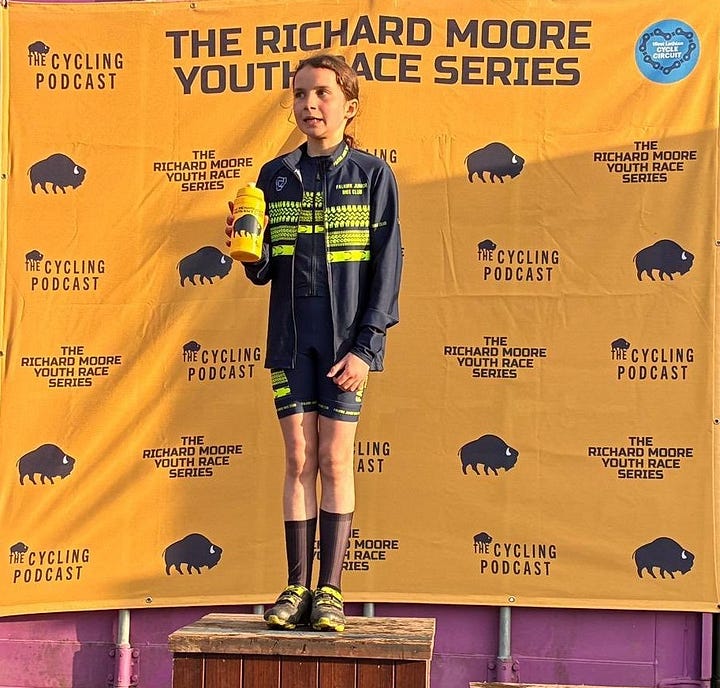
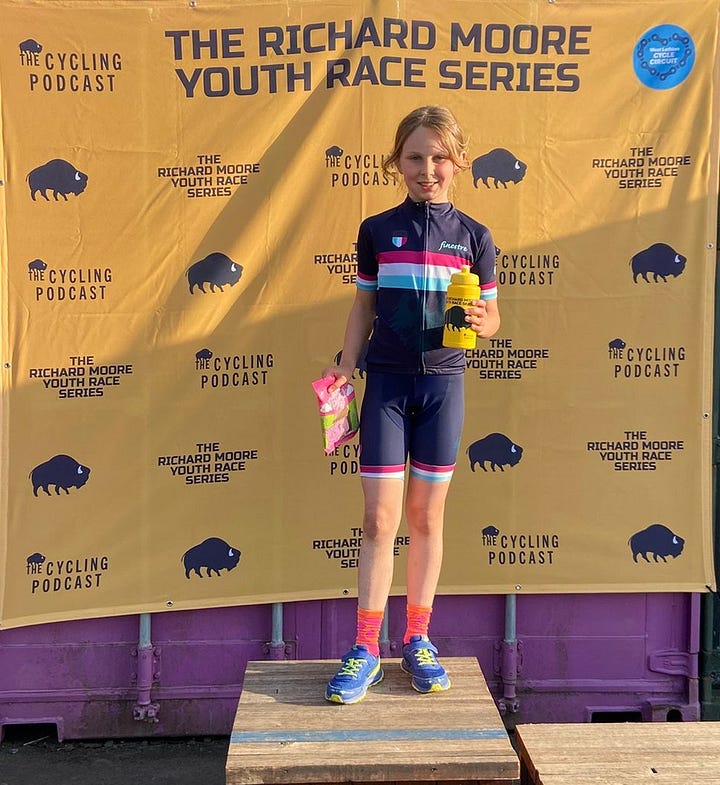
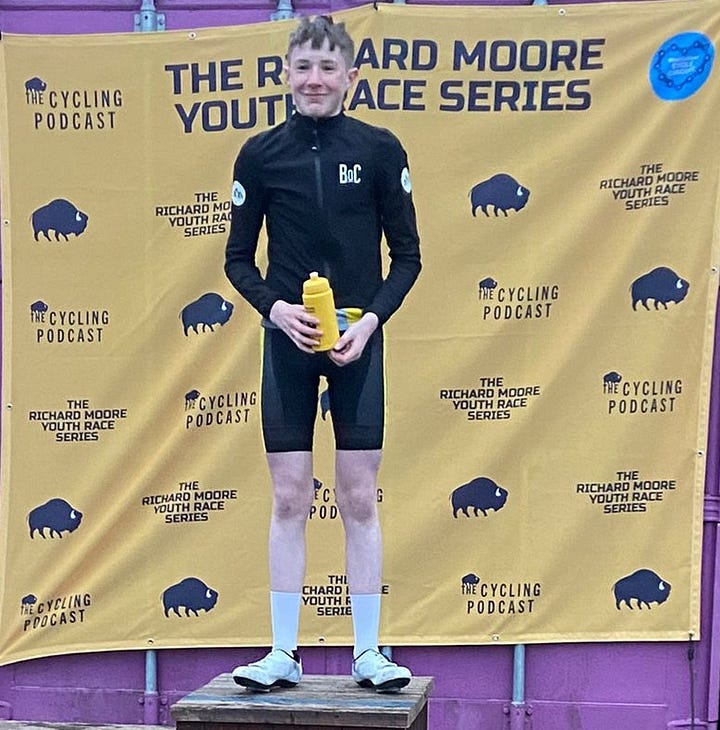
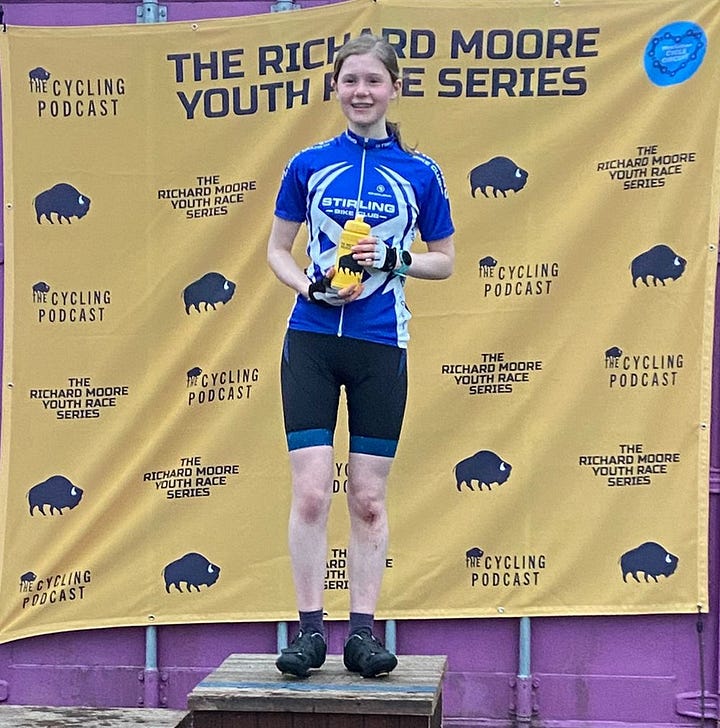
Bold, courageous racing recognised with the Buffalo Award
The second round of the Richard Moore Youth Race Series took place at the West Lothian cycle circuit in Linlithgow, Scotland, last Tuesday. This round was organised by Richard Levinson and Edinburgh RC (Richard Moore’s former club) and saw the biggest number of entrants across all the age groups since the series began last year.
As well as the race winners, the Buffalo Award recognised a mixture of gutsy and determined riding in each event. The idea of the prize is to encourage aggressive, attacking racing, effort and a willingness to put everything on the line even if it doesn’t pay off this time. The type of efforts that catch the eye of the judges include attacking, chasing down a breakaway, hanging on to a lead group, riding a good tactical race, or even riding to catch up after being dropped.
We loved the idea of the Buffalo Award because so much of bike racing is not actually about the winning – after all, there can only be one person who crosses the line first. But by being courageous, bold and resilient, young riders learn skills that can aid their development.
The Richard Moore Youth Race Series
Round two winners (May 13)
Youth D Girls – Charlotte Kyles (Edinburgh RC)
Youth D Boys – Keir Campbell (Sitrling Bike Club)
Youth C Girls – Isla Sim (Johnstone Jets)
Youth C Boys – Alasdair Ogg (Johnstone Jets)
Youth B Female – Eilidh Scally (Johnstone Jets)
Youth B Open – Gregor McNaught (Glasgow Riderz)
Youth A Female – Lucy Sweeney (Edinburgh RC)
Youth A Open – Andrew Levinson (Edinburgh RC)
Buffalo Award winners
Youth D Girls - Isla Patterson
Youth D Boys – Hamish Chumbley (West Lothian Clarion)
Youth C Girls – Rose Martin (Falkirk Junior BC)
Youth C Boys – Alasdair Ogg (Johnstone Jets)
Youth B Female – Emie Smith (Stirling BC)
Youth B Open – Callum Atkinson (Discovery Junior BC)
Youth A Female – Lucy Sweeney (Edinburgh RC)
Youth A Open – Arran Drackford (Falkirk Junior BC)
The next round of the Richard Moore Youth Race Series is on Tuesday, June 17. Visit the British Cycling website to enter.
Our Giro d’Italia coverage continues on Tuesday
Next up, the Tuscan time trial from Lucca to Pisa as the Giro d’Italia resumes following the rest day. Join Daniel and Brian as they guide you through the middle week of the race.




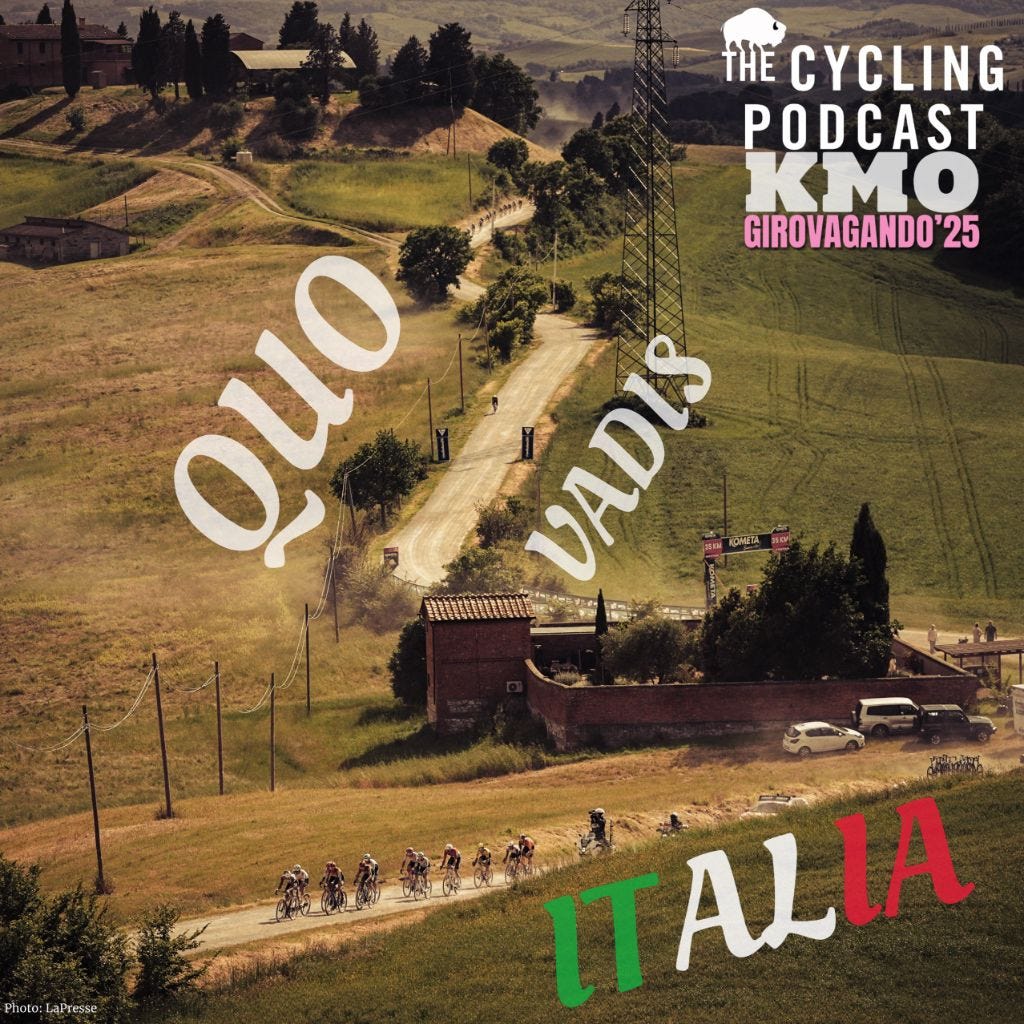
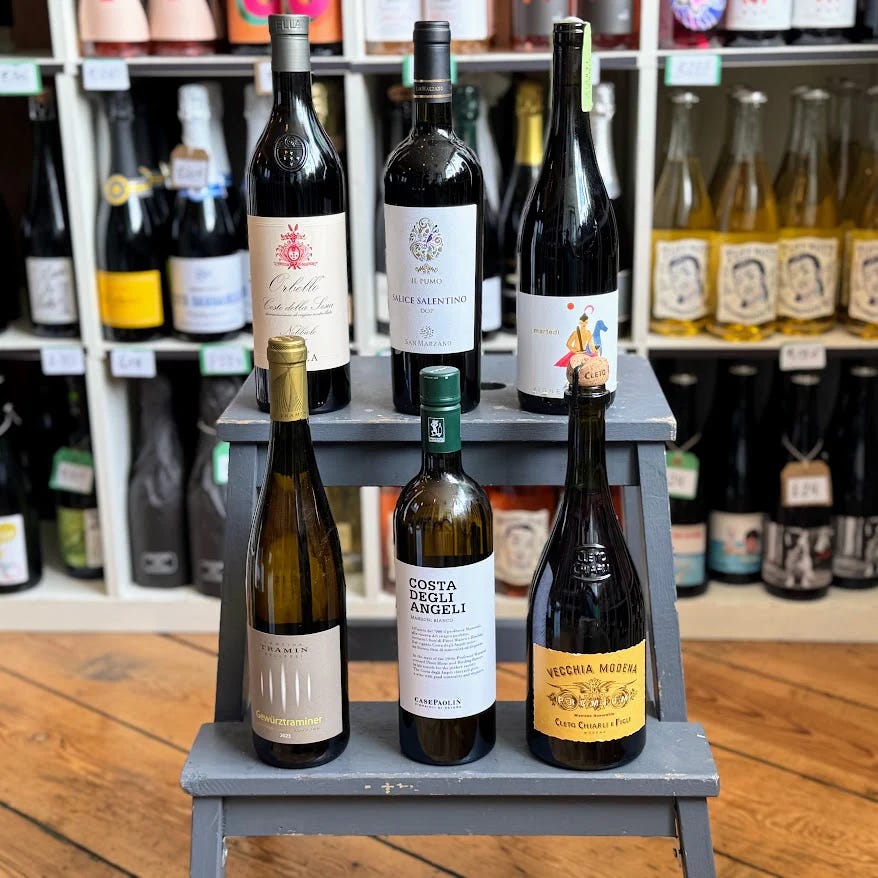

What a fantastic stage. Happy for Wout to get back on the top step but the amount of time he spent literally rubbing Del Toro's back wheel was insane. I'd have been tempted to flick him into a ditch if it was me riding on the front, before he crashed us both! But I'm not riding on the front of Giro stages and Del Toro is the coolest Mexican going so chapeau to him for putting up with it and going into pink.
Ciccone now up into fifth place too - who'd have thought that? It's "fanciful" really! 😉
Definitely looking forward to the wine trial